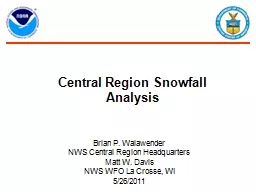

Brian P Walawender NWS Central Region Headquarters Matt W Davis NWS WFO La Crosse WI 5262011 History In the early 2000s NWS offices began creating precipitation analysis graphics for display on their web pages ID: 359610
Download Presentation The PPT/PDF document "Central Region Snowfall Analysis" is the property of its rightful owner. Permission is granted to download and print the materials on this web site for personal, non-commercial use only, and to display it on your personal computer provided you do not modify the materials and that you retain all copyright notices contained in the materials. By downloading content from our website, you accept the terms of this agreement.
Slide1
Central Region Snowfall Analysis
Brian P. Walawender
NWS Central Region Headquarters
Matt W. Davis
NWS WFO La Crosse, WI
5/26/2011Slide2
History
In the early 2000’s, NWS offices began creating precipitation analysis graphics for display on their web pages.
Two primary software packages were utilized for the creation of the graphics
ArcMapGFE Both software packages interpolated the random points into a graphical analysis
2Slide3
Weaknesses of Previous Methods
Manually created, via a multistep process, on a non routine basis
Typically restricted to the local forecast area, requiring the user to view several graphics to see the big picture
Color and contour intervals typically varied from office to office, leading to confusion when viewing graphics from multiple offices.No ability to zoom the graphics or add/remove layers
3Slide4
Central Region Prototype
Collaborative effort between NWS Central Region Headquarters and WFO La Crosse, WI.
Key Requirements
Use commonly available to Open Source GIS toolsAutomatedOutput can be zoomed and pannedConsistent colors and contour intervals
4Slide5
Open Source Tools Utilized
Postgresql
/
PostGIS database – allows for the storing of a geometry object (latitude and longitude in our case) with any database entryGDAL - Geospatial Data Abstraction LibraryUsed perform the interpolation of the raw data into the output analysis graphicUsed perform the contour analysis from the output imageUsed to create the multiday analysis products
5Slide6
Open Source Tools Utilized
Mapserver
– web mapping server used to serve out the raster and
shapefile output productsOpenLayers – web mapping APISimilar to Google MapsAllows for adding interactive maps to web pages
6Slide7
Dataflow
Input data of consists of:
NWS Cooperative Observer Reports
Community Collaborative Rain, Hail and Snow Network (CoCoRaHS) reportsTypical Analysis will consist of about 7500 observationsNWS Local Storm Reports (LSR) were purposely left out because of time range concernsLSR reports currently contain no start, stop or duration information (yet)
7Slide8
Dataflow
Reports are received via LDM from MADIS and
NOAAport
Reports are decoded and databased in realtime Database can hold several months of data
8Slide9
Data Analysis
The scattered point to grid analysis is done via an inverse distance weighted interpolation scheme.
Grid box is a moving1.8
degs, requiring three observations. Inverse power is 6, and output is smooth very slightly at 0.2.Output is a georeferenced tagged image file format (GeoTIFF)2000 x 2000
GeoTIFF
covering CONUS.
9Slide10
Data Analysis
To increase the display performance, the large
GeoTIFF
is converted into polygon shapefile via GDALThe conversion into the polygon shapefile bins the analysis into the standard contour intervals The analysis is run every 30 minutes from 12 UTC until 20 UTC to continuously update the analysis
10Slide11
Multiday Products
Multiday products pose a challenge since there is dilemma on whether or not to include stations that do not report each day of the reporting period
Example – a station reports three days over a four day period – do you use it in a four day analysis
To avoid this concern, the multiday products are created by summing the output analysis for each day in the period, instead of the raw data.11Slide12
Quality Control
An internal web interface allows offices to quality control the analysis
The interface allows the forecaster to flag stations with questionable data, causing them to be removed from the analysis
The analysis is automatically run twice per hour, including new observations, and removing those which were quality controlled.12Slide13
Web Display
The final analysis products are displayed on the web page via an interactive map
The interactive map can be panned and zoomed
The interactive map has multiple layers that can be toggled on and offThe map includes output for the last 24, 48 and 72 hours13Slide14
Web Display
The snowfall analysis can be viewed at:
http://www.srh.noaa.gov/ridge2/snow/index.php
Note this URL may change for the 2011/2012 snow seasonFuture enhancements will included increased resolution, and more observations (Snotel, etc.)
14Slide15
Customer Response
Customer Survey ran from Jan 10
th
until April 30th, 2011300 responses180 users rated the technical quality of the product as a nine or higher (out of ten)207 users rated the ease of use as a nine or higher
15Slide16
Examples
16Slide17
Examples
17Slide18
Examples
18Slide19
Authors
Matt W. Davis
La Crosse, WI Weather Forecast Office
N2788 County Road FALaCrosse, WI 54601
Matt.W.Davis@noaa.gov
Brian P. Walawender
Central Region Headquarters Regional Office
7220 NW 101st Terrace
Kansas City, MO 64153
Brian.Walawender@noaa.gov
19Slide20
QUESTIONS?
20